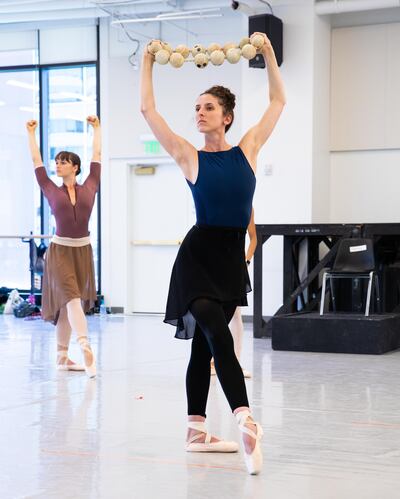SALT LAKE CITY — As the sun reflected off the studio windows of the Capitol Theatre, a delicate surgery was taking place within.
The ailing patient was a ballet — considered to be both a treasure and a troublemaker, a masterpiece and a mockery. The operating team was a collection of choreographers, dancers, social advocates and community arts leaders, attempting to remove some diseased choreography without dismantling the soul and lifeblood of “Le Chant du Rossignol” (Song of the Nightingale).
A few months later, Ballet West is now putting the final touches on this revived 1925 ballet, which has its U.S. premiere at the Capitol Theatre Oct. 25. The Chinese-themed ballet about an emperor healed by a songbird originally included some questionable movement by its Western choreographers — movement that some Asian Americans in Utah considered to be caricatured racial stereotypes. Choreographed by George Balanchine with designs by Henri Matisse and music by Igor Stravinsky, the ballet has undergone a social-consciousness makeover Ballet West hopes will make it bulletproof.

“For many years I have wanted to reconstruct this ballet,” Ballet West artistic director Adam Sklute told members of the community in August. “We have this somewhat antiquated orientalism work of art, and I want you to help me decide what to do about it.”
Once fashionable in the arts, orientalism is essentially a westernized depiction of Asian culture that now carries a stigma of insensitive racial stereotyping. (Imagine head-bobbing, prayer posing and the like.) Ballet West’s reconstructed “Le Chant du Rossignol” is part of a larger movement to examine how people of color are portrayed in the performing arts, and how to update a piece of classic art while maintaining the creator’s intent. Many dance companies, including Ballet West, have made changes in recent years to make dances more culturally sensitive — an endeavor that last year caught the attention of The New York Times.
“Any resistance is just because change is hard, but performing arts are not a static form, and continual interrogation and reinterpretation keeps historical work relevant,” Lane Harwell, a program officer at the Ford Foundation who used to be the executive director of the service organization Dance/NYC, told The New York Times.
Ballet West again returned to this effort, this time asking members of the community to weigh in with their thoughts on the choreography of “Le Chant du Rossignol” during a brief studio rehearsal in August.
“I find that particular movement offensive,” said Judge Michael Kwan of a shuffled step. A handful of other movements such as head-bobbing and prayer poses were also criticized.
Kwan, a Taylorsville justice court judge, spoke out last year when performers from Odyssey Dance Theatre made similar gestures while promoting their “Redux Nut-Cracker” on a local morning show — an event that eventually created an opportunity for the dance company and Utah’s Asian American community to come together and rework the piece.
Another panel member, Salt Lake City Arts Council director Felicia Baca, expressed her hope that the costumes — based on Matisse’s original designs — would strive for accuracy since, in her words, Matisse was an “acknowledged racist” known to “fetishize other cultures.”
“Matisse made an effort to be genuine,” countered ballet historian Kenneth Archer during the panel. Archer and his creative partner, Millicent Hodson, have spent decades reconstructing the nearly-lost work. Hodges added that Matisse fervently researched Chinese culture for accuracy, and noted that Balanchine’s professional and social circles included people from many cultures.
“From 1906 on, for instance, there was a huge influx of dancers from East Asia coming into Russia where Balanchine trained,” Hodges added. “So he borrowed movement from them as colleagues, and they from him — as artists do.”
“That may be important for dance aficionados,” argued Phil Chan, director of Final Bow for Yellowface, an organization that urges performing arts organizations to abandon Asian caricatures. “But for Chinese Americans, it looks like an ugly stereotype.”
Whether to perform the lost work reaches at a fundamental question asked by all who revive aging works of live art, whether by Balanchine, Rodgers and Hammerstein or Shakespeare: Is this piece an artifact? Or is it a living, breathing piece of art open to adjustment?

“Live art is different from art in a museum. It’s not something formerly created like the statue of David — it’s something you’re making fresh every time,” Chan said. “If it’s insulting in today’s context, we don’t need to perpetuate it. Judy Garland performed a black face number in the ’30s — but nobody is suggesting we revive that.”
After years of careful reconstruction, Archer and Hodson allowed their work to go under Ballet West’s scalpel in an effort to avoid possible land mines. Several steps, gestures and movements were removed. Both agreed, according to Sklute in a follow-up letter to the attendees, “that for the work to live and be relevant and important, it must be updated.”
Along with the updated “Le Chant du Rossignol,” Ballet West will showcase two other Balanchine ballets during its upcoming program, both created during the choreographer’s time as ballet master of Paris’ Ballet Russes. (He later moved to the U.S. and co-founded the New York City Ballet.) His 1928 “Apollo” and 1929 “Prodigal Son” are also featured on the triple bill.
“They give us a unique glimpse into the dawn of contemporary ballet,” Sklute said. “They also show us where we can go as we move the art form into the future.”
If you go …
What: Ballet West presents Balanchine’s Ballet Russes
When: Oct. 25-Nov. 2
Where: Janet Quinney Lawson Capitol Theatre; 50 W 200 S, Salt Lake City
How much: $24-$99
Web: balletwest.org


